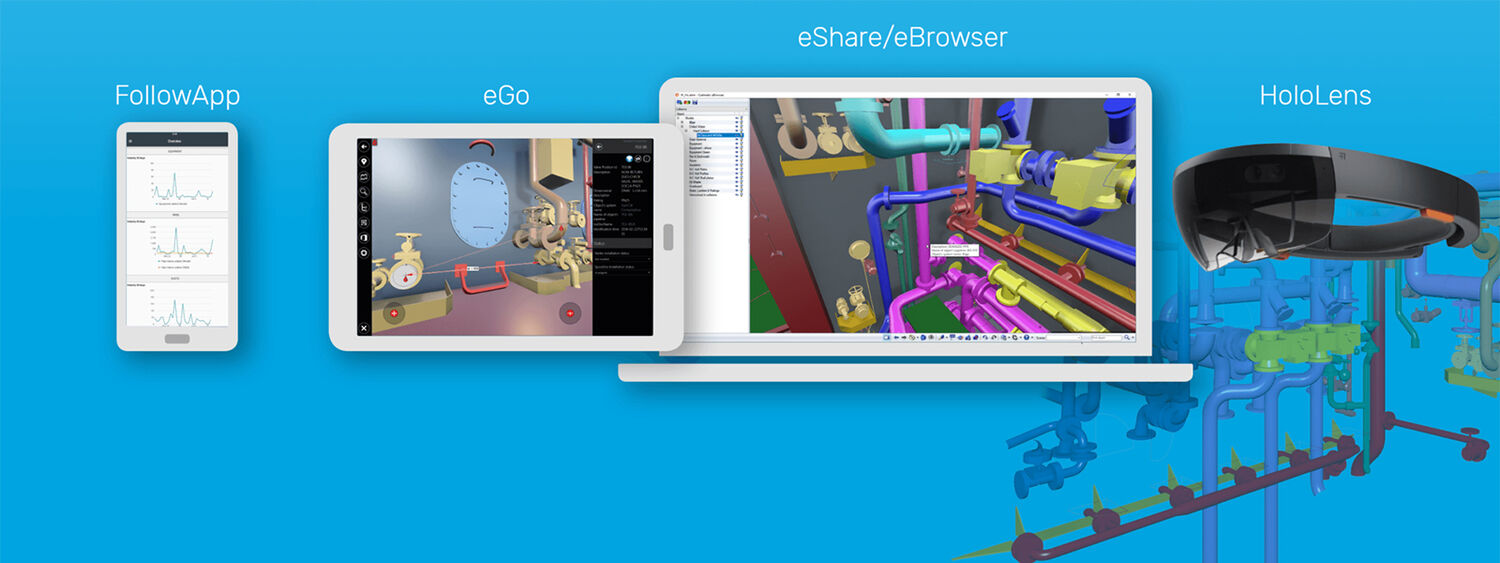
Effective utilization of digital design assets in post-design phases
Posted on January 22, 2019
Over time, ship design has moved from hand-drawn materials to 3D design work, from which drawings and other documents are produced. The design material produced during the design process is still heavily under-utilized during post-design phases such as manufacturing, construction, installation and operation. In this article I discuss, with the aid of examples, how design assets can be effectively utilized to reduce costs and improve the efficiency and quality of the post-design phases.
Digital ship model contains valuable information
The digital ship model created during the design phase contains valuable information for many non-designers: pipe workshop staff, installation teams, and operators. It does not only enable the generation of production documentation, but also acts as a platform for sharing ship-related information.
The digital ship model is usually intelligent, which means that it contains metadata attributes for the items and information about relations between them. It can also contain information external to design applications, such as status information, workflow-related information, instructions, documents, discussions related to the design, purchasing information, logistics information, process information, and so forth.
The digital ship model is useful only if the information is correct, up to date and available; to guarantee this, the same digital ship model is usually shared across all disciplines. This ensures that all project parties always have access to the latest information and that problems in data validity, for example, can be easily identified. Traditionally, this has been achieved via a replication mechanism in multi-site design environments [5] and single-point data access in less complex design environments. Utilizing the digital ship model outside of the office increases the need for synchronization mechanisms to guarantee that offline copies are also sufficiently up to date at any given moment.
Bringing the digital ship model to the construction site
Digital ship models have long been utilized close to construction sites on computers. The increased performance of tablets has, however, opened the door to solutions that make the digital ship model available directly at the construction site. Modern tablets have enough processing power to handle complete digital ship models, even those of the largest cruise ships.
To enable efficient data access, mobile devices need specialized software tools to browse the digital ship model. Mobile devices are often used in environments where no online connections are available. Also, the absence of the traditional input devices may make it difficult to use existing applications that have not been designed for mobile use.
Work at construction sites is commonly based on drawings, lists and other kinds of documentation generated from the digital ship model. Paper-based documentation has several drawbacks. First of all, it needs to be produced. Secondly, the materials are difficult to handle, become easily dated and are not interactive.
It is unlikely that paper-based documentation will completely disappear from construction sites, as its abstract nature makes it quite efficient in some respects. Nevertheless, the presence of a 3D digital ship model can greatly speed up work and reduce costly errors. The digital ship model can also work as an access point to traditional drawings in a digital format, combining the advantages of both platforms.
Easier installation planning
When an installation team is preparing for installation work, it is more efficient to work with the complete design in an easily perceivable format than just looking at static drawings. The 3D model can, for example, be colored to show the current status of the construction and the desired status after the next installation step. The installation team can identify pipe parts used for fit-up and visualize the planned installation order to ensure that it is optimal. The proximity of the items being installed can be checked for items that could cause problems. The digital ship model can also help to find the required materials for installation [3], with its easily readable visual representation of the parts.
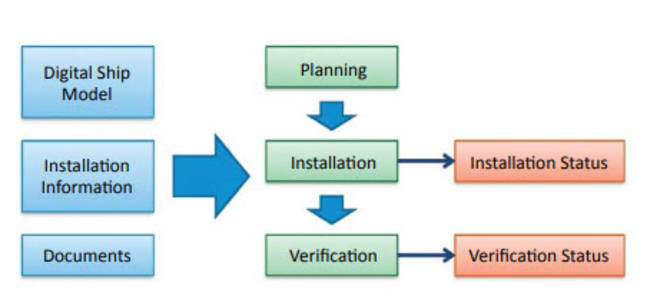
An illustration of the information flow when utilizing digital design assets at construction sites. (2)
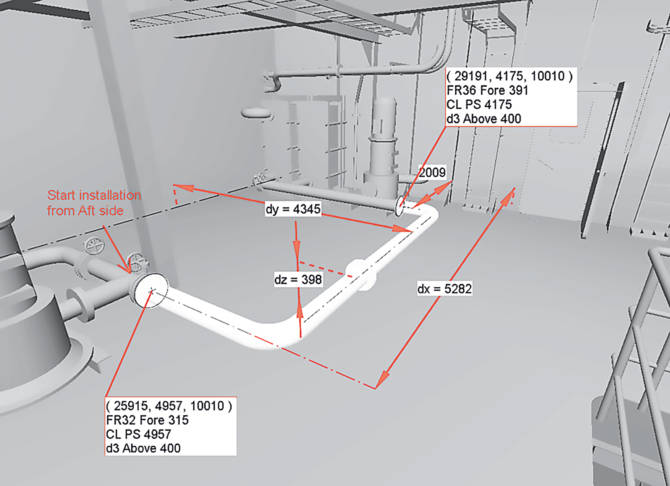
The possibility to check surroundings, add necessary measurements, query item metadata, and add position labels allows the utilization of the digital ship model.
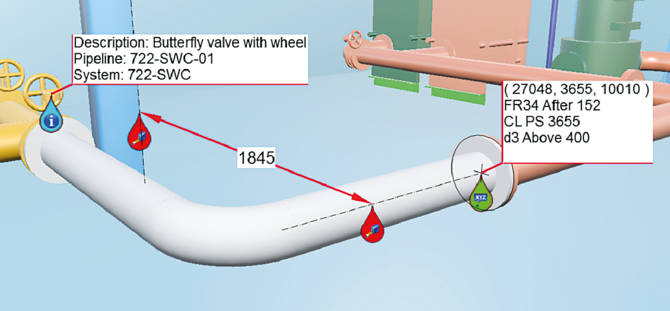
In an interactive drawing the view can be freely rotated, measurements added and removed. All of the information in the digital ship model is available.
Speeding up outfitting installations
During actual construction and installation, the construction staff and installation teams can do the necessary measurements directly on top of the digital ship model. The ability to take measurements reduces the need for installation drawings, which in turn minimizes the time spent on creating documents.
Offline access to the digital ship information allows it to be utilized both during the block outfitting phase and also after the block has been erected and no online access is available. An extra benefit is that the digital ship model can be easily viewed upside-down, which is usually how the block outfitting phase is performed [4]
More accurate reporting
It is challenging to keep track of the status of shipbuilding projects, especially if much work is sub-contracted. Most steps in the building process are related to others – they either block or are blocked by other steps – therefore, successful project execution requires accurate and up-to-date information about which tasks have been completed. Successful execution of lean principles [2], for example, requires a clear view of what other project participants are doing. Several traditional approaches exist to keep track of project progress; these approaches usually require manual work and make use of drawings, or require teams to carry out other paper-based work.
An up-to-date 3D model at a construction site allows the installation team to easily create status reports immediately after the installation. For example, a visual comparison of the reality and the 3D model provides an easy way to check that information that was entered is correct and up to date. This information can then be shared and utilized by synchronizing the information back to the shared digital ship model. This also reduces the probability of errors as manual steps are removed from the process.
Tracking the project status in almost real time is hard to achieve with traditional approaches where the construction status is usually recorded on paper. With digital reporting the project status is up to date and available immediately after the data has been synchronized back to the shared digital ship model.
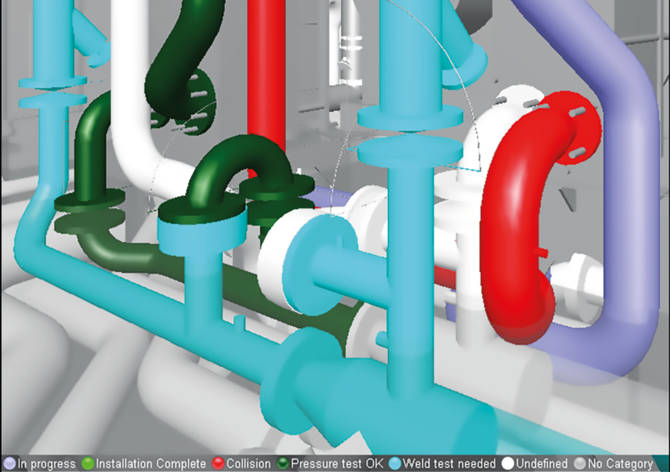
Item statuses are both straight-forward to update and easy to read in the digital ship model.
More controlled verification
In the verification phase, the construction is checked and compared with plans and it is ensured that the construction fulfills the imposed requirements. The digital ship model can function as an easily readable reference to verify that the construction is as designed.
In requirement verification, the model can assist, for example, in weld inspections or in pressure testing piping. The digital ship model can be used as a powerful tool to collect information about parts that have been verified, thereby also guiding the work by showing which parts still need to be checked. Collecting this information in a digital form has the added benefit of making it available to other interested parties. The digital platform can also record who entered the information, thereby improving traceability.
Benefits of the digital ship model in revamp projects
Revamp and retrofit projects can be challenging due to the potential tear-down step; the design and work planning processes must take the items that are going to be removed to make room for new items into account. In addition, the project is usually very fast-paced as the time the ship spends in the shipyard is very limited. This means that project management plays a key role in these projects.
Project management can be facilitated by improving the communication between designers, work planning staff, tear-down crews and installation teams. If a digital model of the ship does not exist, the ship is often laser-scanned and at least partially remodeled to get the as-built model. Based on the as-built model, designers add the required new piping, pumps, etc. The designers also mark the parts that need to be torn down from the existing construction. Visual information shown in the digital ship model makes the tear-down work faster and less error-prone.
By using the digital ship model at the construction site, the progress of the tear-down work can be easily reported, allowing more accurate control over when specific newbuild parts can be installed, thus making it easier to manage activities and also spot tasks that are behind schedule.
CADMATIC approach to information management
CADMATIC has developed an information management ecosystem that allows efficient utilization of the digital ship model. The model can also be used during the manufacturing and construction phases, all the way to the operation phase.
The core of the system is a replicated design tool. Due to the advanced replication mechanism, all designers work with the most recent design. For information management there is a server-based system called eShare, which is connected to the design application and other information sources such as ERP and DMS systems. The shared online data and shared digital model provide access to all the latest design information.
A tablet application called eGo has been developed to use digital ship models at construction sites. It can be connected to the shared digital ship model in eShare. The digital ship model on the tablet can be easily synchronized with the shared digital ship model. The two-way synchronization ensures that all changes in the shared model are visible on the tablet and all status updates made at the construction site are available for all viewers of the shared model.

An illustration of the CADMATIC solution for efficient utilization of design assets in the post-design phases. eShare collects information from both the CAD system and other applications involved and eGo is used for offline access at the construction site.
Watch eShare webinarConclusions
The information produced during the design phase can be utilized in many ways after the actual design phase to improve efficiency and reduce errors.
Using shared digital ship model information during the post-design steps, such as piping installation and pressure checks, improves workflows compared to traditional paper-based approaches. Sharing a single digital ship model between all project parties shortens projects schedules and reduces costs.
At the core of the process is the shared model data, which is up to date and accessible everywhere, including the construction site. The cases shown in this article serve only as examples. As technologies evolve there will be an increasing number of concrete cases in which design assets have been utilized to make the post-design phases more efficient.
References
1. Juntunen, M., ‘Integrated 3d Ship Design and Information Management’, International Conference on Computer Applications in Shipbuilding, 2013
2. Lang, S., et al., ‘Shipbuilding and Lean Manufacturing – A Case Study’, Ship Production Symposium, 2001
3. Tommelein, Iris D., ‘Pull-Driven Scheduling for Pipe-Spool Installation: Simulation of a Lean Construction Technique’, ASCE Journal of Construction Engineering and Management, July/August 1998
4. Chakraborty, S., ‘What Is Advanced Outfitting in Shipbuilding?’, Marine Insight, http://www.marineinsight.com/ naval-architecture/advanced-outfitting-in-shipbuilding/, 2017
5. Juntunen, M., ‘How Can The Most Efficient Design Recourses From All Over The World Be Easily Utilized?’, International Conference on Computer Applications in Shipbuilding, 2011
This article is a shortened version of the paper: ‘Effective utilization of digital design assets in post-design phases’ by Mikko Yllikäinen (MSc) presented at the 18th International Conference on Computer Applications in Shipbuilding (ICCAS), Singapore, 2017.